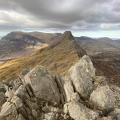Bristly Ridge and Y Gribin - Evening walk and scramble
1 people attending
4 places left
Now the days are getting longer we can avoid the parking problems and the crowds by getting out later on. The added bonus is that you can still get your admin and shopping done during the day!
This route takes us up Bristly Ridge to the summit of Glyder Fach before we descend via Y Gribin. Bristly Ridge is a classic Grade 1 scrambling route given 3-stars in the guidebook (Reeves, 2020). In profile the ridge looks like a fairytale dragons back, the crest of the ridge punctuated by pinaccles. At first glance the ridge combines two great mountaineering qualities: it's beautiful and looks impossible! (Smith, 2014) In reality the scrambling is easier than it looks with huge handholds and grippy rock. This is a challenging route with some difficult moves and exposure. You should be a confident Grade 1 scrambler to sign up to this route, especially as we want to get down before dark!
From the top of the ridge we'll scoot past the summit of Glyder Fach and Castell y Gwynt to scramble down another Grade 1, Y Gribin.
This route involves scrambling and some exposure to heights/falls.
Dogs: If your dog is used to this terrain and has a harness etc then fine. Please let me know in advance.
Drones: Drones are banned by the National Park Authority in certain parts of the park. Please respect their wishes to create a space of solitude and serenity by choosing to leave your drone at home.
Please note that the event may be liable to change or cancellation due to inclement weather.
IMPORTANT! - Participation Statement
You MUST complete a Participation Statement, in addition to booking your event space before attending an OutdoorLads event. You only need to complete this Participation Statement once, not for each event you attend.
Images: Author's own and permission is granted to Outdoorlads for them to be used for this event.
N.B. North Wales Scrambles (Smith 2014) provides a much clearer description of the route than the more recent Rockfax guide by Reeves (2020).








What to bring
Usual mountain kit. Scrambling boots recommended. Please do bring a head-torch too!
Hand sanitiser and a face covering: whilst we are living with Covid-19, please bring your own to events to help keep everyone safe
Water: bring at least two litres in a water bottle, or better still, a hydration bladder
Medicines: if you have hay fever, diabetes, minor ailments etc.
Day Rucksack: typically 20-30 litres, they are comfortable to wear and allow you to use your arms freely
Waterproof bags: keep spare clothing, electronics and anything else dry even when your rucksack leaks by using Ziploc type food bags or, better still, outdoor activity waterproof bags
Boots: waterproof and breathable hiking boots with good ankle support
Gaiters: recommended for wet weather or boggy conditions
Socks: proper walking socks will keep your feet dry and help prevent blisters, and carry a spare, dry pair
Walking Poles: always optional, love them or hate them, but give them a try and decide for yourself
Layered clothing: lets you quickly adapt to changes in the weather and body temperature. Go for a base layer (vest or t-shirt) and a mid layer (a micro fleece or shirt) and in cooler weather add an outer layer (a windproof jacket or thick fleece)
Trousers: no jeans as they become heavy and cold in the rain, breathable fabrics are more comfortable and dry and on warm days shorts are OK
Waterproof jacket: essential when hiking in all but the calmest of weather, breathable fabrics are more comfortable and dry.
Gloves: Windproof, or better still, waterproof gloves are the best choice, bring a spare pair if expecting rain.
Hat or cap: stay warm in winter and shaded in summer
Sunglasses: for any sunny day, even in winter
Sun cream: can be useful even on cloudy and winter days
Snacks: bring biscuits, energy bars, gels, bananas, chocolate or dried fruit for example and put them somewhere easy to get hold of
Lunch: bring a packed lunch unless otherwise stated
Emergency equipment: the walk leader will bring any emergency equipment required for the group, but you are welcome to bring any that you have, such as additional high energy food, a survival bag, a whistle, a medical kit, a torch and something to make fire (either storm proof matches or a firelighter
Map and compass: the walk leader will have these, but if you like map reading or want to develop your skills, bring yours along
Mobile Phone: keep it in a waterproof bag for use in emergencies, and a spare battery/charger is a good idea
Food & drink
A strenuous walk and scramble so bring more snacks and drinks than you think you'll need. Always a good idea to bring an emergency snack too.